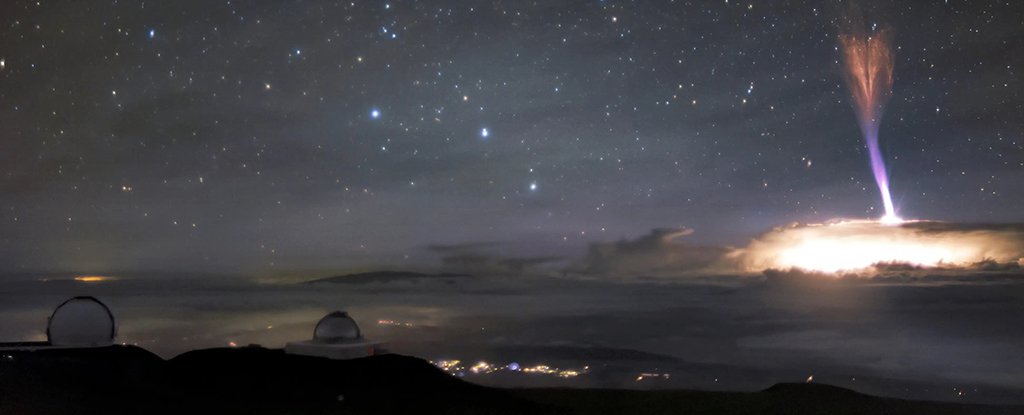
In a stormy Hawaiian sky in July 2017, streaks of red and blue lightning seemed to meet above a bed of white light.
Cameras on the Gemini North telescope at the Gemini Observatory in Mauna Kea captured a stunning photo of the multicolored light show. The National Optical-Infrared Astronomy Research Laboratory (NOIRLab) released the photo Wednesday as “picture of the week”.
The lightning in the image “looks so alien it looks like it must be a special effect,” NOIRLab said. It also published a zoomable version.
These colorful lightning phenomena are aptly known as red sprites and blue jets. They are extremely tricky to capture on camera: the flashes last only tenths of a second and can be difficult to see from the ground as they are generally obscured by storm clouds.
According to Peter Michaud, the education and engagement manager for the NOIRLab, astronomers in nearby Hilo use the telescope’s cameras to remotely monitor the bad weather at the observatory. The camera system takes a picture of the sky every 30 seconds.
“We’ve seen a few other examples of similar phenomena, but that was the best example of a lightning-fast sprite in the upper atmosphere,” he told Insider.
Red, white and blue
Regular white lightning differs from sprites and jets in several important ways. While regular lightning strikes between electrically charged sky, clouds and the ground during storms, sprites and jets start in different places in the sky and move towards space. Their signature shades also set them apart.
Red sprites are ultra-fast bursts of electricity that crackle through the upper regions of the atmosphere – between 37 and 80 km (23 and 49 miles) in the sky – and travel into space. Some sprites are shaped like a jellyfish, while others, like the one in the Gemini Observatory image, are vertical columns of red light with tendrils swinging downward. These are called carrot sprites.
Stephen Hummel, a dark-skies specialist at McDonald Observatory, captured a spectacular image of a jellyfish sprites from a ridge on Mount Locke in Texas last July (below).
![]() (Stephen Hummel)
(Stephen Hummel)
“Sprites usually look to the eye as very short, fuzzy, gray structures. You have to look for them to recognize them, and often I’m not sure I’ve seen one until I’ve checked the camera images to confirm” Hummel told Insider. at the time.
Davis Sentman, who worked as a professor of physics at the University of Alaska Fairbanks, suggested the name ‘sprite’ for the red lightning phenomenon. He said the term was “well suited to describe their appearance” as the word evokes the fairytale, fleeting nature of lightning. Sentman died in 2011.
Blue jets, meanwhile, are born closer to Earth than red sprites. These cone-shaped electric discharges are also brighter than sprites, and they shoot up from the tops of clouds.
Storm clouds can be anywhere from one to 22 kilometers above the Earth’s surface; blue jets will keep moving towards the sky until they reach a height of about 30 miles, after which they disappear. These jets move at speeds in excess of 22,300 mph (9.9 km / s).
![]() (NASA)
(NASA)
Sprites and jets can be seen from space
When lightning strikes the ground regularly, it tends to release positive electrical energy that must be offset by equivalent and oppositely charged energy elsewhere in the air. So sprites and jets are the electrical discharges that balance the equation – that’s why these colorful lightning phenomena occur.
“The more powerful the storm and the more lightning it produces, the more likely it is to produce a sprite,” said Hummel.
Astronauts can sometimes spot sprites and jets from the International Space Station, 402 km (249 miles) above Earth.
Astronaut Andreas Morgensen of the European Space Agency captured on video for the first time in color in 2015. He saw the jets while filming a storm over the Indian Bay of Bengal. Scientists later used the images as part of a 2017 study.
https://www.youtube.com/watch?v=watch
Morgensen’s observations “are the most spectacular of their kind,” the study authors wrote.
This article was originally published by Business Insider.
More from Business Insider: